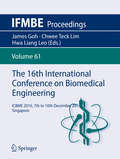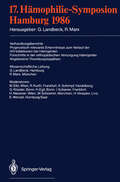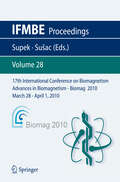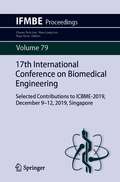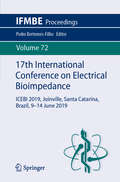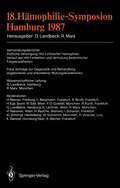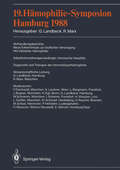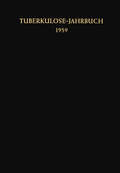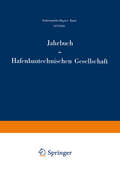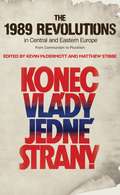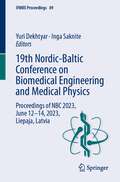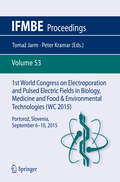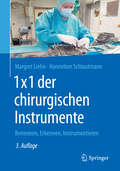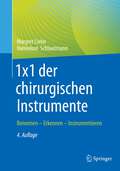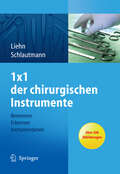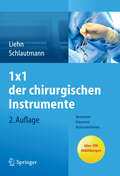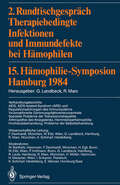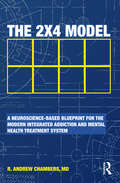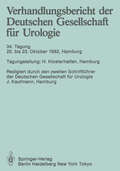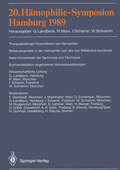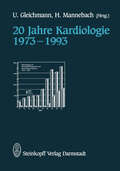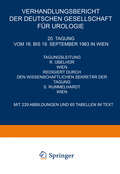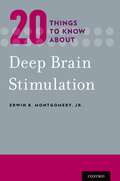- Table View
- List View
The 16th International Conference on Biomedical Engineering: ICBME 2016, 7th to 10th December 2016, Singapore (IFMBE Proceedings #61)
by James Goh Chwee Teck Lim Hwa Liang LeoThis volume presents the proceedings of the 16th ICMBE held from 4th to 7th December 2016, Singapore. Topics of the proceedings include 6 tracks: BioImaging and BioSignals, Bio-Micro/Nano Technologies BioRobotics and Medical Devices, Biomaterials and Regenerative Medicine.- BioMechanics and Mechanobiology., Engineering/Synthetic Biology.
17. Hämophilie-Symposion: Hamburg 1986
by M. Eibl R. Kurth K. Schimpf H. Rössler H. Egli I. Scharrer H. Niessner W. Schramm H. Vinazzer E. Wenzel17th International Conference on Biomagnetism Advances in Biomagnetism - Biomag 2010 - March 28 - April 1, 2010: Biomag March 28 - April 1, 2010 (IFMBE Proceedings #28)
by Selma Supek Ana Susac40th anniversary of "medical uses of SQUID" th It is my great pleasure and honor to invite you to the 17 International Conference on Biomagnetism – Biomag2010 held in Dubrovnik, Croatia from Sunday, March 28 through Thursday, April 1, 2010. The interdisciplinary field of biomagnetism includes dynamic and evolving SQUID-based technologies offering advanced real-time methods for noninvasive assessments of magnetic signals from the brain, heart and other organs as well as a range of modeling, mathematical and computational methods for functional source localization approaches. Excellent spatial resolution and unique, millisecond, temporal resolution of biomagnetic techniques allow insights into cortical neurodynamics and neurobiological basis of the human brain as well as assessment of heart and other organs functions in health and disease. Biomag2010 will be a great opportunity for an exchange of ideas and presentation of the latest developments in instrumentation, modeling approaches, basic and clinical biomedical studies. We are particularly proud to announce the celebration of the 40th anniversary of the first SQUID-based MCG measurements published on April 1, 1970. Since then ''medical uses of SQUID'' were dynamic and growing, including the most recent developments, in combination with a low field MRI, toward a ''direct neuronal imaging''. Dubrovnik, the host city of the Biomag2010, a jewel on the Adriatic, will be a superb and stimulating setting for both scientific and social aspects of this meeting. I am looking forward to hosting you in Dubrovnik, Croatia in spring of 2010.
17th International Conference on Biomedical Engineering: Selected Contributions to ICBME-2019, December 9–12, 2019, Singapore (IFMBE Proceedings #79)
by Chwee Teck Lim Hwa Liang Leo Raye YeowThis book gathers contributions presented at the 17th International Conference on Biomedical Engineering, held on December 9-12, 2019, in Singapore. It continues the tradition of the previous conference proceedings, thus reporting on both fundamental and applied research. It includes a set of carefully selected chapters reporting on new models and algorithms and their applications in medical diagnosis or therapy. It also discusses advances in tele-health and assistive technologies, as well as applications of nanotechnologies. Organized jointly by the Department of Biomedical Engineering of the National University of Singapore and the Biomedical Engineering Society (Singapore), this book offers a timely snapshot of innovative research and technologies and a source of inspiration for future developments and collaborations in the field of biomedical engineering.
17th International Conference on Electrical Bioimpedance: ICEBI 2019, Joinville, Santa Catarina, Brazil, 9-14 June 2019 (IFMBE Proceedings #72)
by Pedro Bertemes-FilhoThis book gathers the proceedings of the 17th International Conference on Electrical Bioimpedance (ICEBI 2019), held on June 9-14, in Joinville, Santa Catarina, Brazil. The chapters cover the latest knowledge and developments concerning: sensors and instrumentation to measure bioimpendance, bioimpedance imaging techniques, theory and modeling and bioimpendance, as well as cutting-edge clinical applications of bioimpendance. All in all, this book provides graduate students and researchers with an extensive and timely snapshot of current research and challenges in the field of electrical bioimpendance, and a source of inspiration for future research and cross-disciplinary collaborations.
18. Hämophilie-Symposion Hamburg 1987: Verhandlungsberichte: Ärztliche Versorgung HIV-1-infizierter Hämophiler: Verlauf der HIV-1-Infektion und Verhütung bedrohlicher Folgekrankheiten Freie Vorträge zur Diagnostik und Behandlung angeborener und erworbener Blutungskrankheiten
by Günter Landbeck R. Marx19. Hämophilie-Symposion Hamburg 1988: Verhandlungsberichte: Neue Erkenntnisse zur ärztlichen Versorgung HIV-infizierter Hämophiler Substitutionstherapie-bedingte chronische Hepatitis Diagnostik und Therapie der Hemmkörperhämophilie
by Günter Landbeck R. MarxThe 1989 Revolutions in Central and Eastern Europe: From Communism to Pluralism (PDF)
by Kevin Mcdermott Matthew StibbeThis important book reassesses a defining historical, political and ideological moment in contemporary history: the 1989 revolutions in central and eastern Europe. Adopting a multi-disciplinary approach, the authors reconsider such crucial themes as the broader historical significance of the 1989 events, the complex interaction between external and internal factors in the origins and outcomes of the revolutions, the impact of the ‘Gorbachev phenomenon’, the West and the end of the Cold War, the political and socio-economic determinants of the revolutionary processes in Poland, Hungary, the German Democratic Republic, Czechoslovakia, Romania and Bulgaria, and the competing academic, cultural and ideological perceptions of the year 1989 as communism gave way to post-communist pluralism in the 1990s and beyond. Concluding that the contentious term ‘revolution’ is indeed apt for the momentous developments in eastern Europe in 1989, this book will be essential reading for undergraduates, postgraduates and specialists alike.
The 1989 Revolutions in Central and Eastern Europe: From Communism to Pluralism
by Kevin Mcdermott Matthew StibbeThis important book reassesses a defining historical, political and ideological moment in contemporary history: the 1989 revolutions in central and eastern Europe. Adopting a multi-disciplinary approach, the authors reconsider such crucial themes as the broader historical significance of the 1989 events, the complex interaction between external and internal factors in the origins and outcomes of the revolutions, the impact of the ‘Gorbachev phenomenon’, the West and the end of the Cold War, the political and socio-economic determinants of the revolutionary processes in Poland, Hungary, the German Democratic Republic, Czechoslovakia, Romania and Bulgaria, and the competing academic, cultural and ideological perceptions of the year 1989 as communism gave way to post-communist pluralism in the 1990s and beyond. Concluding that the contentious term ‘revolution’ is indeed apt for the momentous developments in eastern Europe in 1989, this book will be essential reading for undergraduates, postgraduates and specialists alike.
19th Nordic-Baltic Conference on Biomedical Engineering and Medical Physics: Proceedings of NBC 2023, June 12–14, 2023, Liepaja, Latvia (IFMBE Proceedings #89)
by Yuri Dekhtyar Inga SakniteThis book reports on new trends, challenges and solutions, in the multidisciplinary fields of biomedical engineering and medical physics. Contributions spans from biomechanics, to robotic rehabilitation, radiation oncology, and image and signal processing, among many other topics. They cover advanced devices for diagnosis or patient monitoring, as well as for therapy (non-invasive surgery, rehabilitation and more). Gathering the proceedings of the 19th Nordic-Baltic Conference on Biomedical Engineering and Medical Physics, NBC 2023, held on June 12–14, 2023, in Liepaja, Latvia, this book is expected to inform a wide audience of researchers, engineers and other professionals working in the broad field of biomedical engineering, and to offer a timely snapshot of research and projects that have been carried out within Nordic and Baltic countries, in particular, but not limited to them.
1st World Congress on Electroporation and Pulsed Electric Fields in Biology, Medicine and Food & Environmental Technologies: Portorož, Slovenia, September 6 –10, 2015 (IFMBE Proceedings #53)
by Tomaz Jarm Peter KramarThis volume presents the proceedings of the 1st World Congress on Electroporation and Pulsed Electric Fields in Biology, Medicine and Food & Environmental Technologies (WC2015). The congress took place in Portorož, Slovenia, during the week of September 6th to 10th, 2015. The scientific part of the Congress covered different aspects of electroporation and related technologies and included the following main topics: · Application of pulsed electric fields technology in food: challenges and opportunities· Electrical impedance measurement for assessment of electroporation yield· Electrochemistry and electroporation· Electroporation meets electrostimulation· Electrotechnologies for food and biomass treatment· Food and biotechnology applications· In vitro electroporation - basic mechanisms· Interfacial behaviour of lipid-assemblies, membranes and cells in electric fields· Irreversible electroporation in clinical use· Medical applications: electrochemotherapy· Medical applications: gene therapy· Non-electric field-based physical methods inducing cell poration and enhanced molecule transfer· Non-thermal plasmas for food safety, environmental applications and medical treatments· PEF for the food industry: fundamentals and applications· PEF process integration - complex process chains and process combinations in the food industry· Predictable animal models· Pulsed electric fields and electroporation technologies in bioeconomy· Veterinary medical applications
1x1 der chirurgischen Instrumente: Benennen, Erkennen, Instrumentieren
by Margret Liehn Hannelore SchlautmannPraxiswissen kompakt: OP-Instrumente im ÜberblickDieses Buch bietet allen Fachkräften im OP einen kompakten Überblick der wichtigsten chirurgischen Instrumente und deren Instrumentation. Gleichgültig, ob Sie schon erfahren im OP sind oder der Bereich neu für Sie ist: hier lernen Sie OP- Instrumente besser zuerkennen und sicher einzusetzen. Profitieren Sie von den erfahrenen Autorinnen und meistern Sie Ihren Arbeitsalltag souverän. Ein Fachbuch für alle OP-Fachkräfte, dass Ihnen bei der Einarbeitung neue Mitarbeiter hilft, Anregungen gibt für die Fachweiterbildung oder zum Nachschlagen bei Fragen zum Instrumentarium.
1x1 der chirurgischen Instrumente: Benennen - Erkennen - Instrumentieren
by Margret Liehn Hannelore SchlautmannPraxiswissen kompakt: OP-Instrumente im ÜberblickDieses Buch bietet allen Mitarbeiterinnen und Mitarbeitern im OP - OP-Pflegekräfte und OTAs - einen kompakten Überblick der wichtigsten chirurgischen Instrumente und deren Instrumentation. Gleichgültig, ob Sie schon erfahren im OP sind oder der Bereich neu für Sie ist: hier lernen Sie OP-Instrumente sicher zu erkennen, gezielt vorzubereiten und einzusetzen. Profitieren Sie von den erfahrenen Autorinnen und meistern Sie Ihren Arbeitsalltag souverän. Ein Fachbuch für alle OP-Mitarbeiterinnen und operations-technische Assistentinnen: Für die Einarbeitung neuer Mitarbeiterinnen und Mitarbeiten, Grundlagenwerk für die Fachweiterbildung oder zum Nachschlagen bei Fragen zum Instrumentarium.Neu in der 4. Auflage: Komplett aktualisiert mit über 200 aktuellen Abbildungen.
1x1 der chirurgischen Instrumente: Benennen, Erkennen, Instrumentieren
by Margret Liehn Hannelore SchlautmannDas Praxisbuch liefert alle notwendigen Informationen zu den im Operationssaal eingesetzten Instrumenten und verhilft Lesern damit zu einem sicheren Umgang. Neben Herstellung und Materialkunde vermitteln die Autorinnen auch Praxiswissen über die richtige Vorbereitung, die Verwendung, Handhabung und Pflege der chirurgischen Instrumente. Die wichtigsten Instrumente und die Instrumentation in einem Buch!
1x1 der chirurgischen Instrumente: Benennen, Erkennen, Instrumentieren
by Margret Liehn Hannelore SchlautmannInstrumente und Instrumentation kompakt Endlich ein Praxisbuch, was sich nur auf die Instrumente und die Instrumentation fokussiert - aktualisiert in der 2. Auflage. Mit allen notwendigen Informationen über chirurgische Instrumente, Operationssiebe und –tische und das Buch, das die wichtigsten Fragen von OP-Fachkräften klärt und ihnen Sicherheit im Umgang mit den Instrumenten vermittelt. Grundlagen: Herstellung, Materialkunde, Oberflächenbeschaffenheit Welche Instrumente gibt es und wie werden sie verwendet? Name, Technik, Verwendungszweck Wie werden Instrumente angereicht? Instrumentation, Vorbereitung des Instrumentiertischs, Handling Wie werden Instrumente aufbereitet? Pflege und Aufbereitung von InstrumentenMehr als 200 Abbildungen erleichtern das Erkennen und Unterscheiden einzelner Instrumente. Das Buch bündelt das Fachwissen, welches im OP vorausgesetzt wird. Für neue Mitarbeiter ist das Buch zum Einlernen eine 1A-Untersützung aber auch zum Nachschlagen sollte es in keinem OP-Team fehlen.
2. Rundtischgespräch Therapiebedingte Infektionen und Immundefekte bei Hämophilen: 15. Hämophilie-Symposion Hamburg 1984
The 2 x 4 Model: A Neuroscience-Based Blueprint for the Modern Integrated Addiction and Mental Health Treatment System
by Robert Andrew ChambersOver a quarter century of studies have shown that addictions, mental illnesses, and their combinations (dual diagnoses) are pervasive in the general population. Meanwhile, emerging neuroscience is revealing that the neurodevelopmental basis of major mental illness and addiction diseases are tightly interconnected and often unified pathologies of the brain. This science calls into question the profound split between the addiction and mental health fields that define our fragmented research, professional training, and treatment delivery systems—a split that leaves most patients out of reach of adequate professional expertise and evidence-based standards of care. The 2 x 4 Model, as described in this translational textbook of Addiction Psychiatry, is the essential blueprint and operational manual for the fully integrated, expertly staffed, Dual Diagnosis clinic— a clinic that is maximally capable and efficient in treating the full spectrum of addictions, mental illness, and their comorbidities, through integration of psychotherapies and medications, by one team under one roof. Replication of 2 x 4 Model Clinics into a national system would allow widespread access to excellent, transparent standards of Addiction Psychiatry as a decisive measure against mass incarceration and the exploding health care crisis of untreated addictions, all while rebuilding brain health as a core public health, social and economic imperative of modern society.
The 2 x 4 Model: A Neuroscience-Based Blueprint for the Modern Integrated Addiction and Mental Health Treatment System
by Robert Andrew ChambersOver a quarter century of studies have shown that addictions, mental illnesses, and their combinations (dual diagnoses) are pervasive in the general population. Meanwhile, emerging neuroscience is revealing that the neurodevelopmental basis of major mental illness and addiction diseases are tightly interconnected and often unified pathologies of the brain. This science calls into question the profound split between the addiction and mental health fields that define our fragmented research, professional training, and treatment delivery systems—a split that leaves most patients out of reach of adequate professional expertise and evidence-based standards of care. The 2 x 4 Model, as described in this translational textbook of Addiction Psychiatry, is the essential blueprint and operational manual for the fully integrated, expertly staffed, Dual Diagnosis clinic— a clinic that is maximally capable and efficient in treating the full spectrum of addictions, mental illness, and their comorbidities, through integration of psychotherapies and medications, by one team under one roof. Replication of 2 x 4 Model Clinics into a national system would allow widespread access to excellent, transparent standards of Addiction Psychiatry as a decisive measure against mass incarceration and the exploding health care crisis of untreated addictions, all while rebuilding brain health as a core public health, social and economic imperative of modern society.
20. bis 23. Oktober 1982, Hamburg (Verhandlungsbericht der Deutschen Gesellschaft für Urologie #34)
by J. Kaufmann H. Klosterhalfen20. Hämophilie-Symposion Hamburg 1989: Verhandlungsberichte: Therapiebedingte Virusinfektionen bei Hämophilen. Molekulargenetik der Hämophilie und des von Willebrand-Syndroms. Neue Konzentrate der Gerinnung und Fibrinolyse. Erstmanifestation angeborener Hämostasestörungen.
by Günter Landbeck R. Marx I. Scharrer W. Schramm20. Tagung vom 16. bis 19. September 1963 in Wien (Verhandlungsbericht der Deutschen Gesellschaft für Urologie #20)
by Sepp Rummelhardt20 Things to Know about Deep Brain Stimulation
by Erwin B. Montgomery, Jr.Twenty Things to Know About Deep Brain Stimulation is an extensive and in-depth critical analysis of the field of Deep Brain Stimulation (DBS) from what many may consider a revolutionary perspective. This book demonstrates the unique nature and incredible promise of DBS and shows how it is unparalleled as a therapeutic intervention. Dr. Montgomery provides an epistemic analysis of the presuppositions, assumptions and fallacies underlying current clinical understanding of DBS as well as the physiology and pathophysiology affected by DBS. Reviews of the safety and efficacy for a number of conditions, patient selections and issues in the post-operative management are also included. Given the revolutionary potential and the complexity of DBS in an ever changing healthcare delivery context, the ethics of DBS are discussed in detail.
